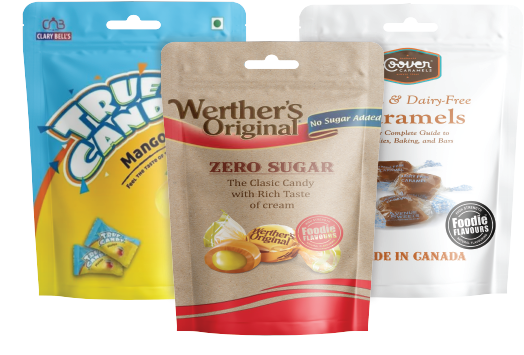Candy Packaging plays a crucial role in attracting consumers and preserving the freshness and quality of sweet treats. It serves not only as a protective barrier but also as a powerful marketing tool.
Here are key aspects to consider when it comes to candy packaging:
- Visual Appeal: The visual appeal of Candy Packaging is a crucial aspect that can significantly influence consumer purchasing decisions. Eye-catching designs and vibrant colours are essential for Candy Packaging. Here are key considerations for enhancing the visual appeal of candy packaging:
Colour Palette: Choose a vibrant and eye-catching colour palette that aligns with the brand and the type of candy. Bright colours often evoke positive emotions and attract attention.
Texture and Finish: Explore different textures and finishes to add tactile appeal to the packaging. Matte or glossy finishes, embossing, or metallic elements can create a premium look and feel.
Uniqueness and Innovation: Stand out from the competition by incorporating unique and innovative design elements. Whether it’s a novel shape, creative patterns, or interactive features, innovation can capture consumer interest.
Minimalism or Bold Designs: Depending on the brand personality and the type of candy, opt for a minimalist design or go for bold and extravagant visuals. The design should align with the product and brand image.
The visual appeal of candy packaging goes beyond aesthetics – it communicates the essence of the brand and influences consumer perception. Striking the right balance between creativity, coherence, and relevance is key to creating packaging that captivates and resonates with the target audience.
Materials:
Candy packaging materials play a critical role in preserving the freshness, quality, and visual appeal of the candies. The choice of packaging material depends on factors such as the type of candy, shelf life requirements, environmental considerations, and cost. Here are some common materials used in candy packaging:
Foil: Aluminium foil is often used in Candy Packaging due to its excellent barrier properties against light, oxygen, and moisture. Foil is commonly used for wrapping individual candies or for creating pouches and laminates.
Paper and Cardboard: Paper and cardboard are popular for various Candy packaging types, including boxes and cartons. They are versatile, allowing for creative printing and branding. However, they may require additional coatings or laminations to enhance barrier properties.
Glass: Glass jars and containers are used for premium and specialty candies. While glass provides an excellent barrier against external factors, it is heavier and more fragile than other materials.
Wax Paper: Wax paper is a traditional packaging material used for wrapping certain types of candies. It provides a protective layer and is often chosen for nostalgic or artisanal products.
Packaging Types:
There are various packaging types for candies, such as bags, boxes, jars, and blister packs. The choice depends on the type of candy, shelf life requirements, and the desired consumer experience.
- Branding and Information: Incorporate branding elements like logos and taglines. Include essential information such as ingredients, nutritional facts, and allergy warnings, complying with relevant regulations.
- Sustainability: The sustainability of Candy packaging is a complex issue that involves considering various environmental, social, and economic factors. Here are some aspects to consider:
Biodegradability: Choose packaging materials that are biodegradable or compostable to minimise the environmental impact. Biodegradable packaging breaks down naturally over time, reducing the amount of waste in landfills.
Energy Efficiency in Production: Evaluate the energy consumption and emissions associated with the production of packaging materials. Opt for materials that have a lower environmental footprint in terms of energy use and greenhouse gas emissions.
Social Impact: Consider the social aspects of packaging production, such as fair labour practices and the social impact on communities. Ethical and socially responsible practices contribute to overall sustainability.
Regulatory Compliance: Stay informed about local and international regulations related to packaging materials. Complying with these regulations can ensure that the packaging meets certain environmental standards.
Ultimately, achieving sustainability in candy packaging involves a holistic approach that considers the entire lifecycle of the packaging material, from production to disposal. Collaboration among candy manufacturers, packaging suppliers, and consumers is crucial to making progress in this area.
- Innovative Features: Stand out in the market by incorporating innovative features like resealable zippers, unique shapes, or interactive elements that engage customers and enhance their overall experience.
- Seasonal and Limited Editions: Introduce special packaging for holidays or limited-edition releases to create a sense of urgency and excitement among consumers.
- Protection and Durability: The protection and durability of Candy Packaging are essential considerations to ensure the product’s quality, safety, and appeal. Packaging serves as a barrier to protect candies from external factors such as physical damage, moisture, air, light, and contamination.
- Cost-Effective Solutions: Strive for a balance between quality and cost-effectiveness. Optimise packaging designs to minimise material usage while maintaining product integrity.
- Consumer Convenience: Consider ease of use for the consumer. Packaging should be user-friendly, easy to open, and resealable if necessary.
Conclusion
In the world of confectionery, Custom Brand Packaging transcends mere functionality; it is a canvas for creativity, a guardian of freshness, and a silent yet powerful brand ambassador. From the vibrant visual allure that captures hearts on the shelves to the intricate dance of materials balancing preservation and sustainability, candy packaging is an intricate tapestry that weaves together the practical and the emotional. As we navigate the delicate balance between innovation, sustainability, and consumer convenience, the sweet success of Candy Packaging lies not just in protecting the delectable treats within but in creating an experience that delights the senses and resonates with the values of today’s consumers.

